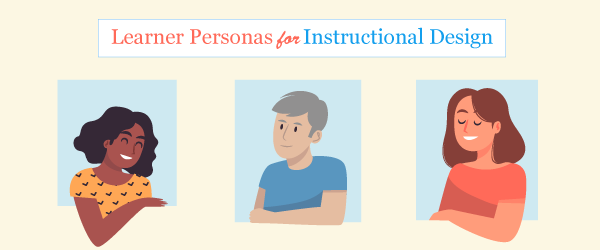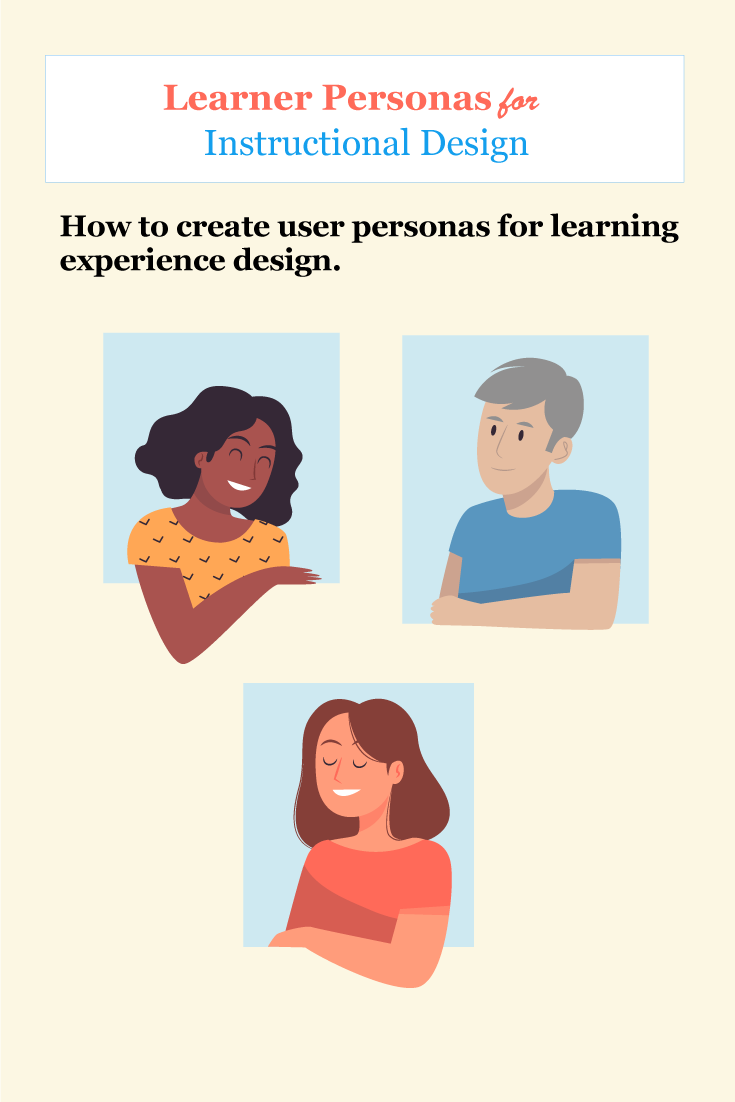
One thing we can learn from the field of User Experience Design is how to create user personas, better known as learner personas in the world of eLearning. What is a persona? It is a well-developed fictional profile that reflects the characteristics of the audience groups you are designing for.
These audience groups share common characteristics, such as their training goals, job responsibilities, educational background, attitudes, skills and behaviors. Every course has at least one audience group and most courses have several.
Why Develop Learner Personas?
Creating a learner persona can help designers become more aware of their audience. Thinking through what a particular audience group needs and how they will react as they proceed through a course provides a tangible focus for the design. With a persona in mind, the designer might build more engaging lessons and discover new ways that learners can construct knowledge. Developing learner personas makes the abstract idea of your audience into something concrete.
In truth, many designers probably carry around a model of what their audience members are like. But developing personas helps to formalize the models so they can be documented, shared and used throughout the design process. This creates a consistency and unity in who your audience members are across the entire design and development team. Here is a three-step process.
Step One: Gather Information First
The most effective personas are going to emerge out of an audience analysis that includes interviews and real conversations with sample audience members as well as supervisors and stakeholders in the training. This is one of the best ways to ensure your personas reflect reality rather than a projection of your ideal learner. For help with conducting interviews, see Best Practices for Interviewing Your Audience. Other sources of information might come from your client’s printed collateral and website or discussions with subject matter experts or personnel office.
You can gain additional insight about your audience by using empathy maps. This article explains how: Empathy Maps: A Tool for Learning Experience Design.
Step 2: Write Your Learner Persona
With this information in hand, write a descriptive profile of an audience group member. Give this person a name and borrow traits from real individuals of the group if you were lucky enough to hold interviews. Describe your persona’s demographics, job responsibilities, motivations for taking the training, experiences at work, attitude toward online learning, skill and educational levels and so on. Some groups go so far as to add a photo to their persona. Developing personas can be a collaborative process done with team members or created solo.
Step 3: Use The Learner Persona
In the end, you should have several learner personas that provide a tangible sense of your audience members. Always share them with your team. Keep the personas in mind throughout design and development as though they are someone you know. Refer to them. Converse about them. Make them your imaginary friend. “Would Kathy want to spend her time playing this game?” “What would it take for Ahmed to pass the certification test?”
The Persona Debate
In User Experience circles there is an ongoing debate over whether personas are a help or a hindrance. Some contend that personas are a poor approach for understanding the needs and wants of the audience. Detractors say that personas promote distance between designers and users; that they are a product of what designers wish their users would be like. They say personas don’t reflect unique individuals and they prevent designers from having empathy for their users.
Avoid the Persona Traps
My recommendation would be to try personas the next time you’re working on a project with multiple audience groups. Then follow these tips to avoid the traps:
- Try to have conversations with sample members of your audience groups. Even a few conversations can help you remember the individuals behind the persona.
- Ensure the use of personas helps your team personalize and customize the design. If you find it has the opposite effect, you’re headed down the wrong path.
- Watch that stereotypes and social judgments don’t slip into your personas. These unrealistic profiles defeat the purpose.
- Build empathy for the audience groups. The more you can imagine their life and their story, the more likely you are to understand who they are.
Examples of Personas in Other Fields
Because it’s important to step out of your field, you can learn more about personas from user experience design and marketing. Reviewing the personas in the articles below can give you an idea of how to develop personas for instructional design audiences.


I totally agree and as Ken Allan above has stated, as a Lecturer and Trainer myself designing learner for Personas is what we did intuitively in Differentiation of Learning. We also had to ensure we challenge and stress learners. It was a regular Ofsted requirement. Since 2002, I have been using blogs and Moodle to deliver learning and creating materials using Hot Potatoes and Quia, if anyone remembers these. Authoring Tools now mirror a lot of what these applications were allowing you to create online. I love everything software too so this article resonates so much with my Career Journey as an Instructional Designer (ID).
Instructional Design has taken many elements of Teaching Methodologies and rebadged them with names that are new but Learning is Learning. What makes learning different is your approach, knowing your audience and designing to that audience need. This may take having a generic known list of personas based on research or require new research to deliver to those personas and archetypes. Ultimately, if you enjoy the learner lighting up with ideas and really understanding what you have just taught – that for me is Success. Being able to do this for an infinite number of people at anytime everyday takes time and patience.
I loved changing my career from Lecturing and Training to becoming an ID. I now get to impact the learning of people I may never meet but will always remember what they were taught because of patient and consistent implementation of meeting ‘The Learners Needs’ with engaging and interactive learning.
I love Instructional Design
Oh yes the personas have helped me and I sure I shall try to include the trick as I will be designing my training program. I would say that the WMO facilitators used this trick when they were designing the trainer of trainers course which i am undertaking. We were to tell our learning experiences and to select the topic that each one of us teach. It is now that i have realized that it was done because we are a mixed audience. So the facilitators wanted to have knowledge of the different personalities. I salute this resource.
Has anyone found good examples of learner personas? I’ve tried to look for a sample statement or document but haven’t been able to find anything.
Yes, it can really be a big help.
I use personas when I develop online help and training documentation. It forces me to really have a good understanding of my audience.
Greetings Ken. I agree, knowing the audience is paramount to success. Building learner personas is simply a technique that might help an entire design team have a consistent approach to the audience and help them get more in tune with audience members. Sounds like you’re already there!
Kia ora e Connie!
I agree with what you say here, though I’m aware that there is nothing new in the ideas.
As a teacher, past trainer and as an educator, I have always believed that considering the target group of learners was paramount to learner success. This can include examining the individual needs within that group.
Catchya later
from Middle-earth
Great example. Thanks.
I’ve used learner personas, and first learned about them from the Marketing Department.
Advertisers need to know to whom they market, so they create personas.
I adapted their approach to e-learning soon after. It helped me create a non-linear course for 401(k) “newbies” and employees fairly well versed who simply needed to know how to sign up.
The personas helped me tell the 401(k) story for each type of learner; true-to-life stories that engaged the learner.
@jenisecook